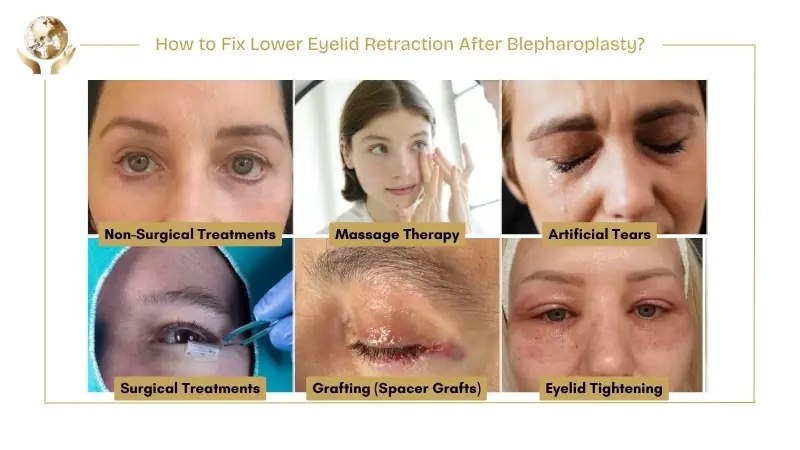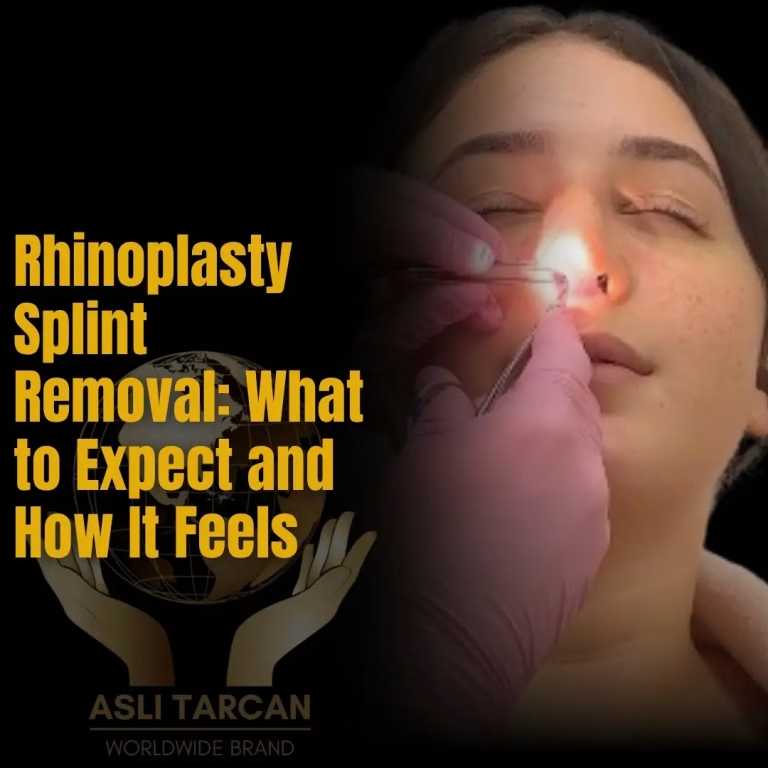How to Fix Lower Eyelid Retraction After Blepharoplasty?
Lower eyelid retraction after blepharoplasty, a cosmetic eyelid surgery, is a common abnormality. It’s a side effect in which the eyelid is pulled downward excessively, which makes the eyes look unnatural and causes irritation and discomfort. So, how to fix lower eyelid retraction after blepharoplasty?
If it’s mild, you can consider non-surgical treatments to address it, such as massage and artificial tears or ointments. However, if it’s severe, you may need to undergo complex surgical procedures such as spacer grafts and eyelid tightening.
Let’s learn in detail about the lower eyelid retraction after eyelid surgery, its causes, and how to fix it with surgical and non-surgical treatments.

What Is Eyelid Retraction After Blepharoplasty?
Out of many abnormalities caused by blepharoplasty due to side effects, the lower eyelid retraction is at the top of the list.
In this condition, the lower eyelid is pulled excessively downward instead of sitting in the normal position, which causes dryness, irritation, and discomfort in the eyes.
It also gives the face an unnatural and surgical appearance, which is a main concern why most people who want it removed.
The treatment used to treat the lower eyelid retraction depends on how severe it is. If it’s mild, the non-surgical treatments may work for it. If it’s severe, more complex surgical treatments may be required.
Causes Of Lower Eyelid Retraction After Blepharoplasty
The causes of the lower eyelid retraction after eyelid surgery include too much skin removal, over-tightening, scar tissue formation, weak eyelid muscles or tendons, swelling and poor healing and the ageing or the previous surgeries.

Too Much Skin Removed
If, due to any surgical error, the surgeons remove too much of the skin or tissue from the eyelids, it can cause the eyelid to get pulled downward. Because the eyelid muscle lacks sufficient support, and doesn’t have enough strength to keep the lower eyelid.
Over-Tightening of Eyelid
When the surgeons over-tighten the eyelid, this makes the eyelid sit lower than it should.
Scar Tissue Formation
After the healing, there may be scars that could shrink or pull the eyelid downward.
Weak Eyelid Muscles or Tendons
When the muscles or the outer corner tendon (canthus) are weak, they can’t support the eyelid properly. Then the eyelid droops downwards.
Swelling and Poor Healing
Swelling can push the eyelid down, and poor healing or uneven tissue recovery can change the eyelid position.
Ageing and Previous Surgeries
Older people have less strength and the elasticity in their skin. When they get any cosmetic surgeries like this one, it can lead to weak support structures, increasing the risk of the lower eyelid retraction after blepharoplasty.
How to Fix Lower Eyelid Retraction After Blepharoplasty?
Both surgical and non-surgical treatments are available for the lower eyelid retraction after blepharoplasty.

Non-Surgical Treatments
If it’s the mild lower eyelid retraction post-eyelid surgery, these are the effective non-surgical eyelid treatments for it.
Massage Therapy
A gentle massage every day can soften the tight tissues and help the eyelid to move naturally to its place, reducing the pulling. Just make sure that you do it gently, following the instructions of your surgeon.
Artificial Tears and Ointments
You can use the artificial tears and ointments as well to control the dryness, burning, and irritation from the eyelid not closing fully. It’ll keep you comfortable and your eyes protected.
Surgical Treatments
If the eyelid is pulled down excessively, these surgical options may be needed to fix it.
Grafting (Spacer Grafts)
Grafting, which is also known as the spacer grafts, is a treatment in which small pieces of tissue, such as the hard palate, cartilage or special material, are placed inside the eyelid. These work like a spacer to lift and support the eyelid in its proper position.
Eyelid Tightening
When the lower eyelid retraction is mild, around 2 mm or less, eyelid tightening may work the best. In this treatment, the outer corner of the eyelid is tightened, giving it support and helping it to sit in the proper position again.

Asli Tarcan Clinic: Youthful Eyes Without Eyelid Retraction
How to fix lower eyelid retraction after blepharoplasty? The treatment required to correct the eyelid retraction depends on its severity. If it’s mild, you can try out the non-surgical treatments, including the massage, artificial tears, or ointments. If it’s severe, the surgical treatments may be required, which include grafting and eyelid tightening.
We recommend trying non-surgical treatments first as they’re easy to do and home-based. If they don’t work for you, you should move on to the surgical treatment with your surgeon’s advice.
If you’re considering blepharoplasty, contact Asli Tarcan Clinic, as with decades of experience, our board-certified plastic surgeon knows how to avoid this issue in the first place. We’ll make your eyes youthful-looking without any complications like eyelid retraction. Contact us today.

This article is medically reviewed by Ophthalmologist Dr. Mehmet
See Our Doctors & Surgeons
How to treat lower eyelid retraction after blepharoplasty?
If it’s mild, it can be treated with non-surgical treatments like massage or ointments. If it’s severe, surgical procedures such as grafts or tightening may be needed.
How common is lower lid retraction after blepharoplasty?
It’s a common complication of lower eyelid blepharoplasty, but it can be avoided if the plastic surgeon is experienced enough and uses personalised techniques.
How to fix a slight pull-down on the lower eyelid after blepharoplasty?
If it’s a slight pulling of the eyelid, you can improve it with regular massage, artificial tears, ointments, and lubricants.






